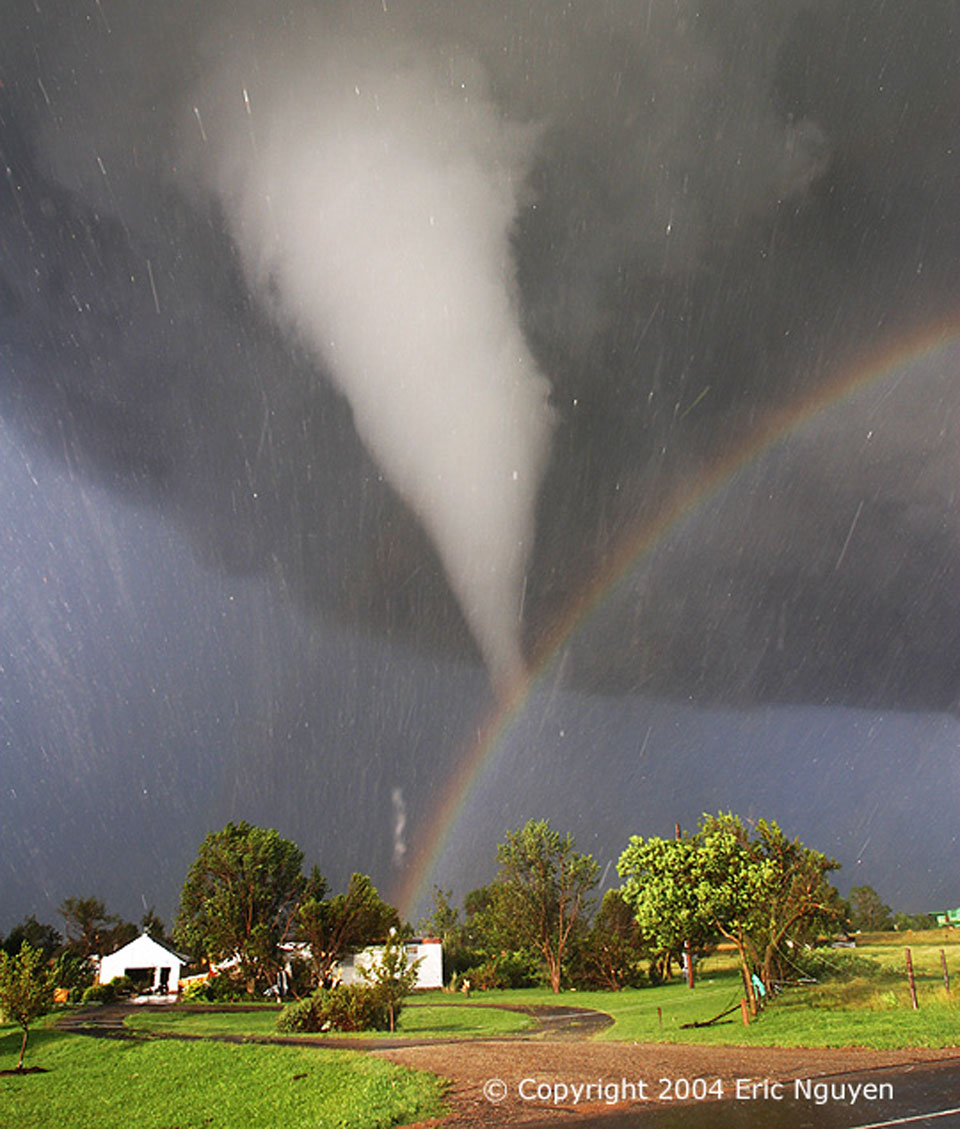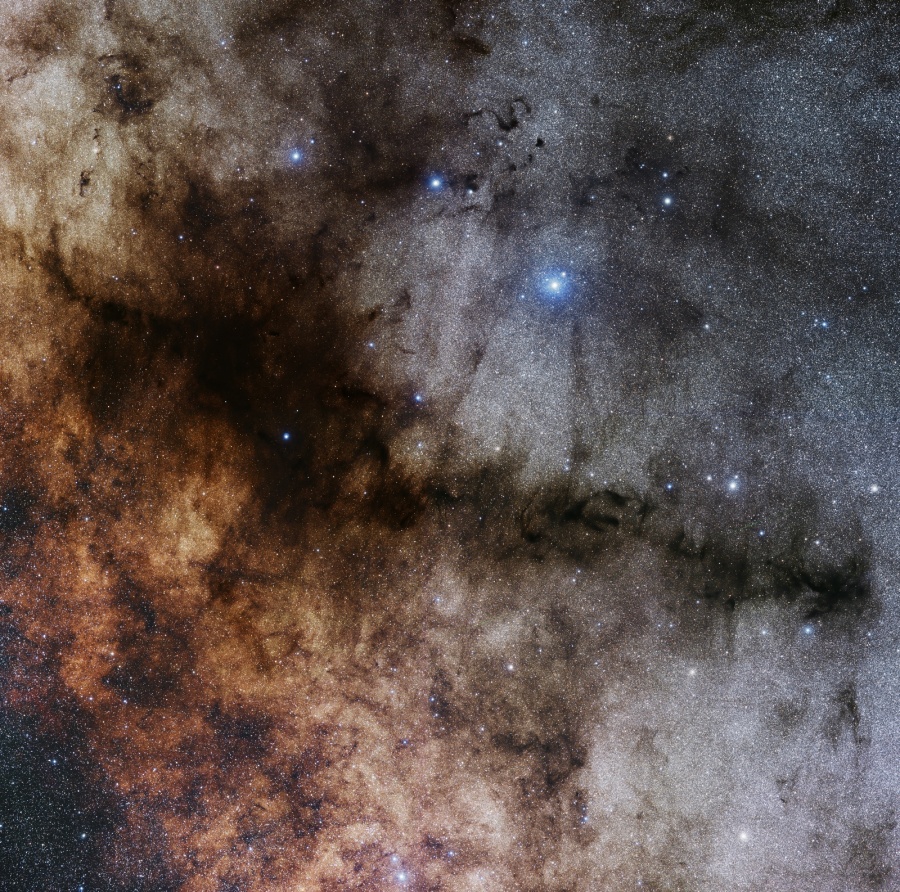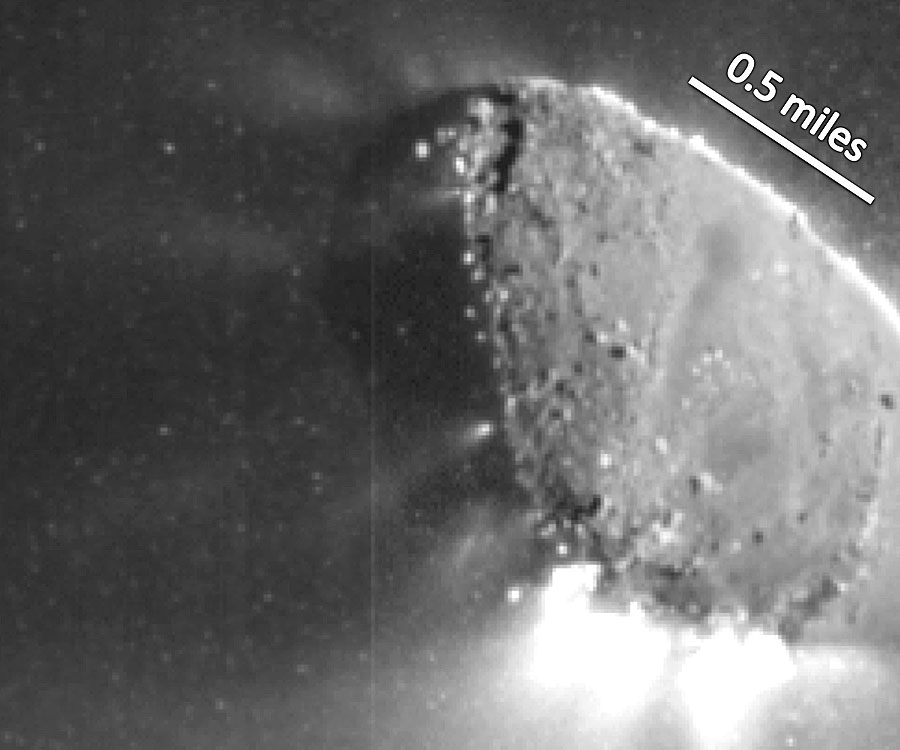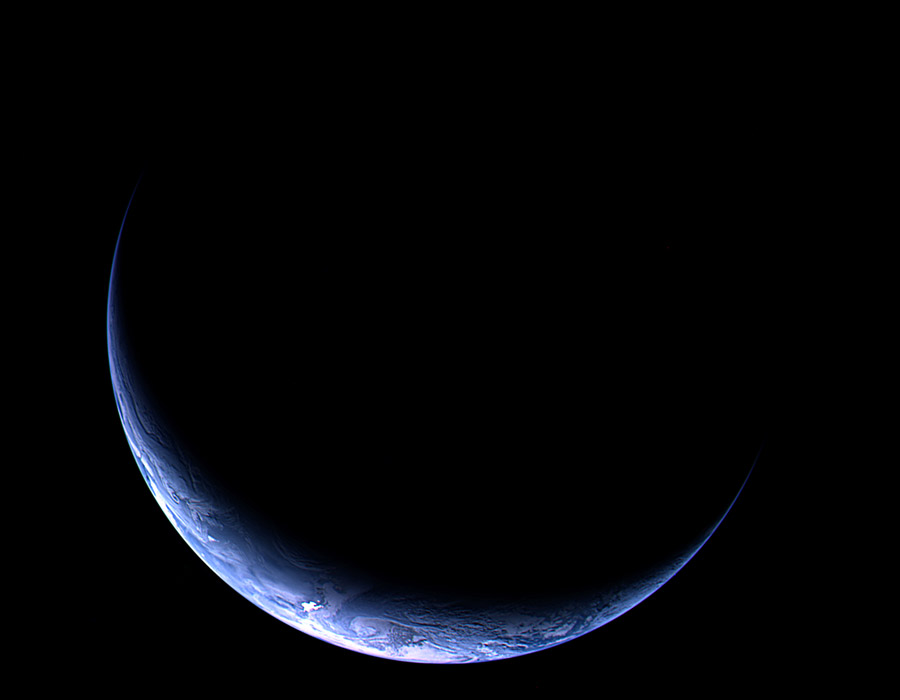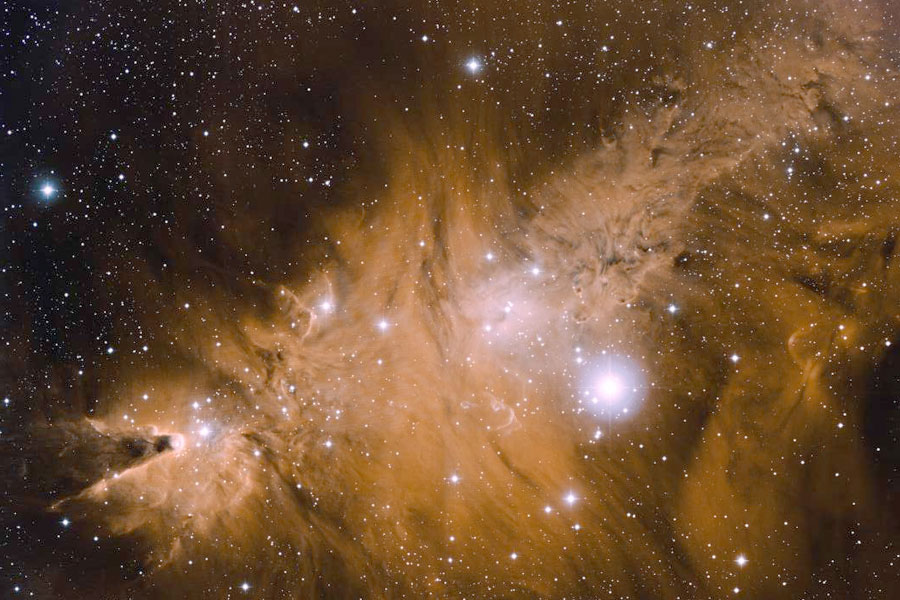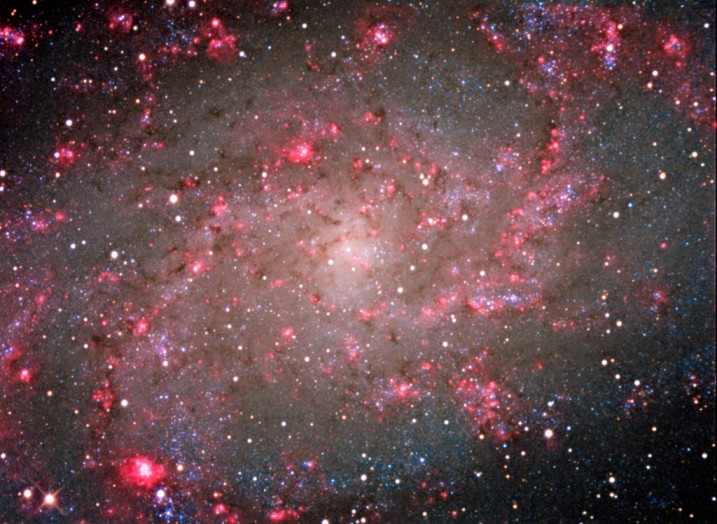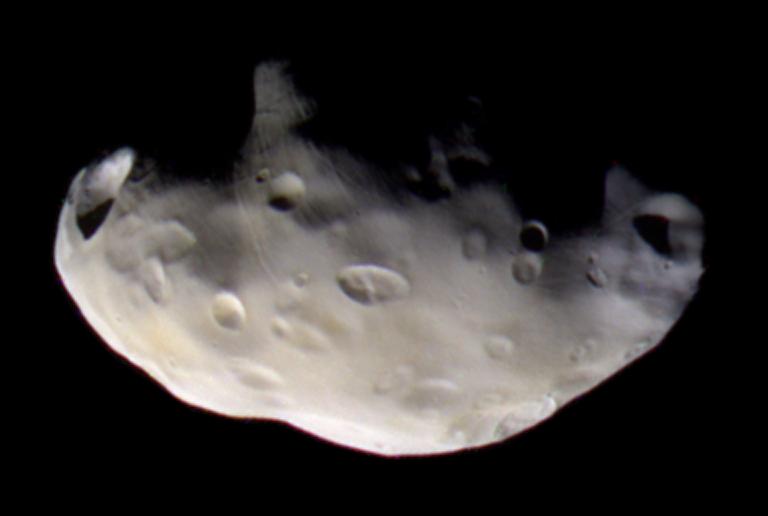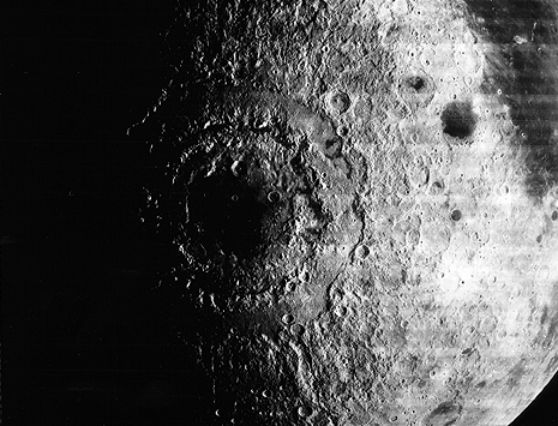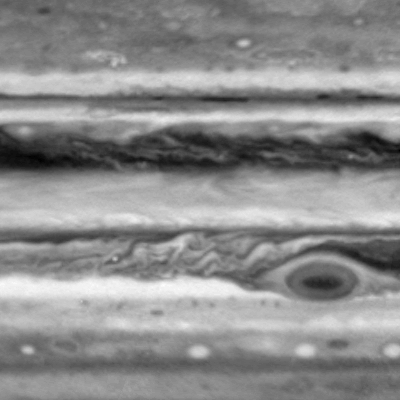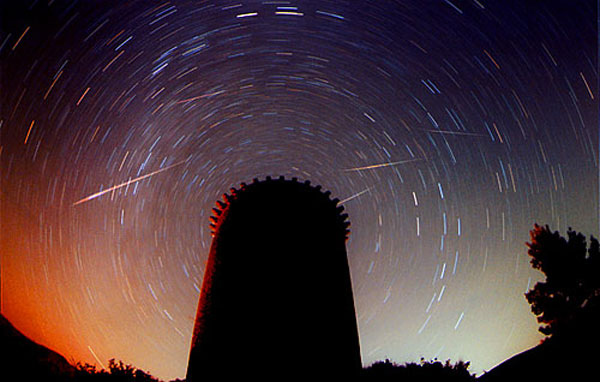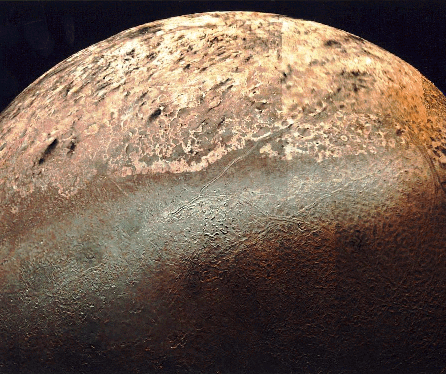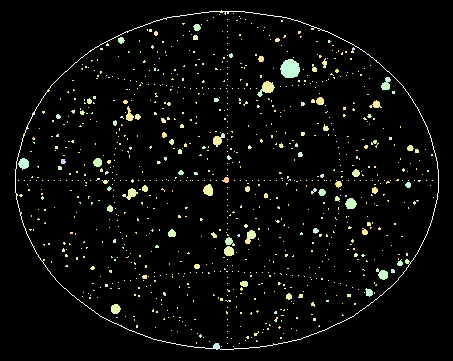| << Previous | Index | Next >> |
2014 The scene might have been considered serene if it weren't for the tornado. During 2004 in Kansas, storm chaser Eric Nguyen photographed this budding twister in a different light -- the light of a rainbow. Featured here, a white tornado cloud descends from a dark storm cloud. The Sun, peeking through a clear patch of sky to the left, illuminates some buildings in the foreground. Sunlight reflects off raindrops to form a rainbow. By coincidence, the tornado appears to end right over the rainbow. Streaks in the image are hail being swept about by the high swirling winds. Over 1,000 tornadoes, the most violent type of storm known, occur on Earth every year, many in tornado alley. If you see a tornado while driving, do not try to outrun it -- park your car safely, go to a storm cellar, or crouch under steps in a basement.
2013 Still intact, on November 21 Comet ISON (C/2012 S1) swept into this animated field of view (left) from the HI-1 camera on the STEREO-A spacecraft. The camera has also captured periodic Comet Encke, Mercury, and Earth, with the Sun cropped out of the frame at the right, the source of the billowing solar wind. From STEREO's perspective in interplanetary space, planet Earth is actually the most distant of the group, seen in its orbit beyond the Sun. Mercury is closest, but both planets are still so bright they create sharp vertical lines in the camera's detector. Both comets clearly sport substantial tails, but ISON is closer to the camera and will continue to move more rapidly through the field. Cameras on STEREO and SOHO spacecraft will be able to follow Comet ISON as it falls towards its close encounter with the Sun on November 28, even as ISON gets more difficult to see in the bright dawn skies of planet Earth.
2012
2011 From an altitude of over 5,000 meters, the night sky view from Chajnantor Plateau in the Chilean Andes is breathtaking in more ways than one. The dark site's rarefied atmosphere, at about 50 percent sea level pressure, is also extremely dry. That makes it ideal for the Atacama Large Millimeter/submillimeter Array (ALMA) designed to explore the universe at wavelengths over 1,000 times longer than visible light. Near the center of the the panoramic scene, ALMA's 7 and 12 meter wide dish antennas are illuminated by a young Moon nestled in the arc of the Milky Way. ALMA's antenna configurations are intended to achieve a resolution comparable to space telescopes by operating as an interferometer. At left, a meteor's streak and the Milky Way's satellite galaxies, the Large (bottom) and Small Magellanic Clouds grace the night.
2010 Unusual jets have been discovered emanating from Comet Hartley 2. The EPOXI spacecraft imaged the jets in unprecedented detail during its flyby of the comet earlier this month. Pictured above, sun-illuminated jets shoot away from the two-kilometer long decaying iceberg that orbits the Sun between Earth and Jupiter. Comet Hartley 2 became active recently as it neared the Sun and sunlight warmed the comet. Preliminary analyses of images like that shown above indicate that the smooth regions around the middle are porous and leak frozen water vapor directly out into space. Unexpectedly, however, the rough regions at either end appear to shoot carbon dioxide jets that expel fluffy snowballs, some as large as basketballs, from the nucleus. Many of the dots in the above image are thought to be snowballs. The unusual jets will continue to be studied, and may yield further clues as to how comets and asteroids formed and evolved during the early years of our Solar System. Comet Hartley 2 is slowly evaporating and may completely break up over the next 1,000 years.
2009 Goodbye Earth. Earlier this month, ESA's interplanetary Rosetta spacecraft zoomed past the Earth on its way back across the Solar System. Pictured above, Earth showed a bright crescent phase featuring the South Pole to the passing rocket ship. Launched from Earth in 2004, Rosetta used the gravity of the Earth to help propel it out past Mars and toward a 2014 rendezvous with Comet Churyumov-Gerasimenko. Last year, the robot spacecraft passed asteroid 2867 Steins, and next year it is scheduled to pass enigmatic asteroid 21 Lutetia. If all goes well, Rosetta will release a probe that will land on the 15-km diameter comet in 2014.
2008 Strange shapes and textures can be found in neighborhood of the Cone Nebula. The unusual shapes originate from fine interstellar dust reacting in complex ways with the energetic light and hot gas being expelled by the young stars. The brightest star on the right of the above picture is S Mon, while the region just above it has been nicknamed the Fox Fur Nebula for its color and structure. The blue glow directly surrounding S Mon results from reflection, where neighboring dust reflects light from the bright star. The orange glow that encompasses the whole region results not only from dust reflection but also emission from hydrogen gas ionized by starlight. S Mon is part of a young open cluster of stars named NGC 2264, located about 2500 light years away toward the constellation of Monoceros. The origin of the mysterious geometric Cone Nebula, visible on the far left, remains a mystery.
2007 Braided, serpentine filaments of glowing gas suggest this nebula's popular name, The Medusa Nebula. Also known as Abell 21, this Medusa is an old planetary nebula some 1,500 light-years away in the constellation Gemini. Like its mythological namesake, the nebula is associated with a dramatic transformation. The planetary nebula phase represents a final stage in the evolution of low mass stars like the sun, as they transform themselves from red giants to hot white dwarf stars and in the process shrug off their outer layers. Ultraviolet radiation from the hot star powers the nebular glow. The Medusa's transforming hot central star is visible in the detailed color image as the small blue star within the upper half of the overall bright crescent shape. Fainter filaments clearly extend above and to the left of the bright crescent region. The Medusa Nebula is estimated to be over 4 light-years across.
2006 Gorgeous spiral galaxy M33 seems to have more than its fair share of hydrogen. Its inner 30,000 light-years are shown here in an image processed to fully reveal the reddish glow of ionized hydrogen regions (HII regions) sprawling along loose spiral arms that wind toward the galaxy's core. Historically of great interest to astronomers, M33's giant HII regions are some of the largest known stellar nurseries - sites of the formation of short-lived but very massive stars. Intense ultraviolet radiation from the luminous, massive stars ionizes the surrounding hydrogen gas and ultimately produces the characteristic red glow. A prominent member of the local group of galaxies, M33 is also known as the Triangulum Galaxy and lies about 3 million light-years distant.
2005 What does Saturn's small moon Pandora look like? To help find out, the robot Cassini spacecraft now orbiting Saturn passed about 50,000 kilometers from the unusual moon in early September. The highest resolution image of Pandora ever taken was then captured and is shown above in representative colors. Features as small as 300 meters can be discerned on 80-kilometer wide Pandora. Craters on Pandora appear to be covered over by some sort of material, providing a more smooth appearance than sponge-like Hyperion, another small moon of Saturn. Curious grooves and ridges also appear to cross the surface of the small moon. Pandora is partly interesting because, along with its companion moon Prometheus, it helps shepherd the particles of Saturn's F ring into a distinct ring.
2004
[imghover6=http://apod.nasa.gov/apod/image/0411/leonid1_nsl.jpg]http://apod.nasa.gov/apod/image/0411/leonid2_nsl.jpg[/imghover6]Credit: Night Sky Live Project
2003 What's lighting up the Cigar Galaxy? M82, as this irregular galaxy is also known, was stirred up by a recent pass near large spiral galaxy M81. This doesn't fully explain the source of the red-glowing outwardly expanding gas, however. Recent evidence indicates that this gas is being driven out by the combined emerging particle winds of many stars, together creating a galactic "superwind." The above recently released photograph from the new Subaru Telescope highlights the specific color of red light strongly emitted by ionized hydrogen gas, showing detailed filaments of this gas. The filaments extend for over 10,000 light years. The 12-million light-year distant Cigar Galaxy is the brightest galaxy in the sky in infrared light, and can be seen in visible light with a small telescope towards the constellation of Ursa Major.
2002 Like a target ring bull's-eye, the Mare Orientale is one of the most striking large scale lunar features. Located on the Moon's extreme western edge, this impact basin is unfortunately difficult to see from an earthbound perspective. It is over 3 billion years old, about 600 miles across and was formed by the impact of an asteroid sized object. The collision caused ripples in the lunar crust resulting in the three concentric circular features visible in this 1967 photograph made by NASA's Lunar Orbiter 4. Molten lava from the Moon's interior flooded the impact site through the fractured crust creating a mare. Dark, smooth regions on the moon are called mare (Latin for sea), because early astronomers thought these areas might be oceans.
2001 In the clear, dark and moonless predawn hours of November 18, Greenbelt, Maryland's local baseball field was packed. The crowd stared skyward and occasionally conversed in hushed and reverent tones. "How many did you count?" a man asked. Some had long since lost track ... but others were keeping score, counting hundreds of Leonid meteors in a short hour's worth of skygazing. Farther to the west, near Florence, Arizona, recreational astronomers also gathered to enjoy the celestial show. Taken from that location, this single, 10 minute, wide-angle exposure captured a dozen or so Leonid meteors. The shooting stars are clearly seen to be streaming from the shower's radiant point in the constellation Leo.
2000 Everything is big on Jupiter, the solar system's reigning gas giant. For example, Jupiter's Great Red Spot is a hurricane-like storm system at least twice the diameter of planet Earth. Approaching Jupiter in early October the Cassini spacecraft recorded the images used in this excellent movie of the swirling storm system and planet-circling cloud bands. Seven mosaicked frames make up the movie sequence, each separated by one or two rotation periods (Jupiter rotates about once every 10 hours). The sequence is viewed as a simple cylindrical map projection spanning 50 degrees north to 50 degrees south of the Jovian equator. Can you see the small bright "clouds" which seem to suddenly appear west (left) of the Red Spot? Data from the Galileo spacecraft, orbiting Jupiter since 1996, suggest that these features are large lightning storms. Saturn-bound, the Cassini spacecraft will take a few months to fly by Jupiter, coordinating Jovian explorations with Galileo and picking up speed for the final leg of its interplanetary journey.
1999 The 1999 Leonids Meteor Shower came to a tremendous crescendo. Observers in Europe observed a sharp peak in the number of meteors visible around 0210 UTC during the early morning hours of November 18. Meteor counts then exceeded 1000 per hour - the minimum needed to define a true meteor storm. At other times and from other locations around the world, observers typically reported respectable rates of between 30 and 100 meteors per hour. The above photograph is a 20-minute exposure ending just before the main Leonids peak began. Visible are at least five Leonids meteors streaking high above the Torre de la Guaita, an observation tower used during the 12th century in Gorina, Spain.
1998 Click on the above image and watch a Leonid meteor explode. The tremendous heat generated by the collision of a small sand-bit moving at 70 kilometers/second with the Earth's upper atmosphere causes the rock-fragment to heat up, glow brightly, and disintegrate. In some cases, the meteor literally explodes leaving a visible cloud that dissipates slowly. The above image shows just such an explosion for a bright meteor from the recent Leonid Meteor Shower. Clicking on the above image will start a (4.2 Megabtye) movie of thirty 1-minute exposures showing the explosion cloud dissipate. Each movie frame, taken with the ROTSE telescope early 17 November, is 8 degrees across - 16 times the diameter of the full moon. Near the middle of the sequence, a less bright meteor moves through the field.
1997 On October 10th, 1846, William Lassell was observing the newly discovered planet Neptune. He was attempting to confirm his observation, made just the previous week, that Neptune had a ring. But this time he discovered that Neptune had a satellite as well. Lassell soon proved that the ring was a product of his new telescope's distortion, but the satellite Triton remained. The above picture of Triton was taken in 1989 by the only spacecraft ever to pass Triton: Voyager 2. Voyager 2 found fascinating terrain, a thin atmosphere, and even evidence for ice volcanoes on this world of peculiar orbit and spin. Ironically, Voyager 2 also confirmed the existence of complete thin rings around Neptune - but these would have been quite invisible to Lassell!
1996 Gamma Ray Bursts (GRBs) pose one of the greatest mysteries of modern astronomy. About once a day, the gamma-ray sky lights up with a spectacular explosion. No one knows what causes these explosions or even how far away they are. The above map represents the entire sky in coordinates centered on our Galaxy, the Milky Way. It shows the positions of over 800 of these mysterious bursts of energy detected by the BATSE instrument on board NASA's Compton Gamma Ray Observatory. Before BATSE, most astronomers thought that most GRBs occurred in the disk of our Galaxy, but the above sky map shows little sign of this. The distance scale of GRBs was the topic of a historic debate in April 1995. The positions in the above map are currently being studied in great detail in an effort to uncover a clue about the nature of GRBs. In the above 3B map created by R. Nemiroff, spot size is proportional to peak flux and spot color is indicative of hardness.
1995 The Crab Nebula resulted from a star that exploded - a supernova. Although the stellar explosion that caused the Crab Nebula was seen over 900 years ago, the nebula itself still expands and shines. Much of the emitted light has been found to be polarized. Light waves with the same polarization vibrate in the same plane. Light waves can be polarized by reflection from a surface, an effect familiar to sunglass wearing fishermen and skiers. Polarized light can also be emitted by regions that contain strong magnetic fields. Areas of different polarization above are highlighted by different colors. Mapping the polarization helps astronomers decipher which physical processes create the observed light.
| << Previous | Index | Next >> |
